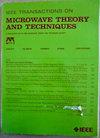Optically Modulated Split Ring Resonator Sensor for Optical Density Analysis of Liquid Analytes in Microwave Regime
IF 4.1
1区 工程技术
Q2 ENGINEERING, ELECTRICAL & ELECTRONIC
IEEE Transactions on Microwave Theory and Techniques
Pub Date : 2024-10-03
DOI:10.1109/TMTT.2024.3461568
引用次数: 0
Abstract
Conventional optical sensors are insensitive to the variations in the dielectric properties of materials, while typical microwave sensors are insensitive to the variations in the material’s optical properties. This work presents a photoresponsive microwave split ring resonator (SRR) sensor designed for the simultaneous analysis and characterization of both the dielectric and optical properties of the liquid analytes. Through the integration of a light-sensitive element (photoresistor) into the SRR, the proposed method enables the microwave sensor to characterize the optical density of the liquid analyte while distinguishing the dielectric properties of the sample. In the designed system, optical illumination with blue light (求助全文
约1分钟内获得全文
求助全文
来源期刊

IEEE Transactions on Microwave Theory and Techniques
工程技术-工程:电子与电气
CiteScore
8.60
自引率
18.60%
发文量
486
审稿时长
6 months
期刊介绍:
The IEEE Transactions on Microwave Theory and Techniques focuses on that part of engineering and theory associated with microwave/millimeter-wave components, devices, circuits, and systems involving the generation, modulation, demodulation, control, transmission, and detection of microwave signals. This includes scientific, technical, and industrial, activities. Microwave theory and techniques relates to electromagnetic waves usually in the frequency region between a few MHz and a THz; other spectral regions and wave types are included within the scope of the Society whenever basic microwave theory and techniques can yield useful results. Generally, this occurs in the theory of wave propagation in structures with dimensions comparable to a wavelength, and in the related techniques for analysis and design.
 求助内容:
求助内容: 应助结果提醒方式:
应助结果提醒方式:


